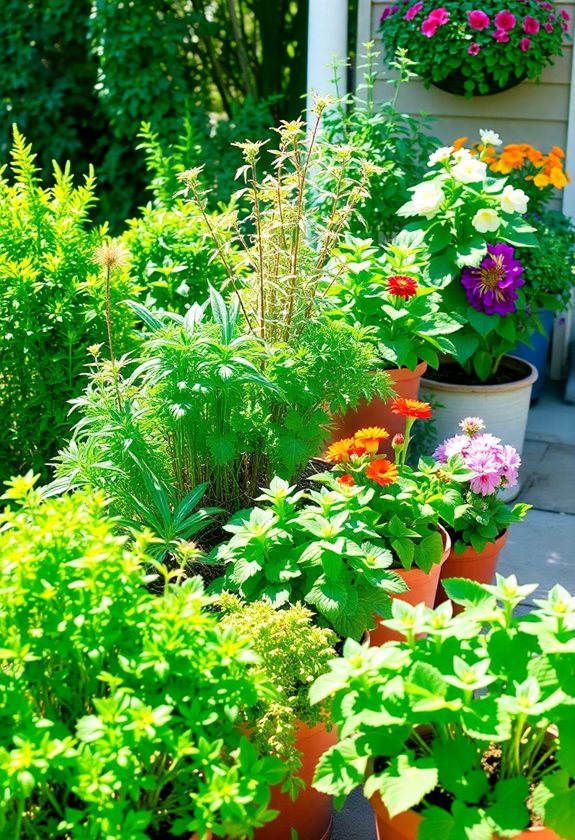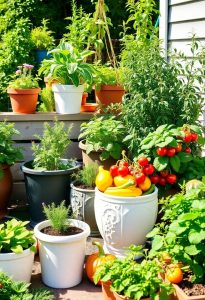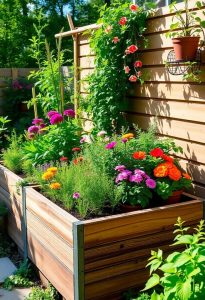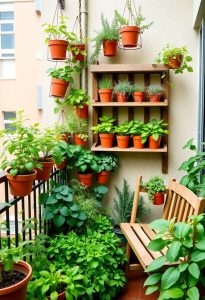Want to keep your garden flourishing all year? Start by choosing the right containers with drainage holes—think plastic, ceramic, or even reclaimed wood for a unique flair! Fill them with quality potting soil that retains moisture but drains well. Remember to water deeply but less often, and match your plants with their light needs—like tomatoes love full sun! Excited to learn more tips and tricks for successful year-round container gardening? Let’s uncover more together!
Design Highlights
- Choose containers with proper drainage and materials that reflect your style while ensuring they suit the plant types you want to grow.
- Use high-quality, lightweight potting soil enriched with organic matter to promote healthy plant growth and prevent root suffocation.
- Water deeply but infrequently, checking soil moisture to maintain optimal hydration without overwatering or under-watering your plants.
- Select plants based on their light requirements, ensuring full sun, partial sun, or shade-loving species are placed in suitable locations.
- Incorporate low-maintenance plants and plan container arrangements early to simplify spring transitions and maintain a vibrant garden year-round.
Choosing the Right Containers
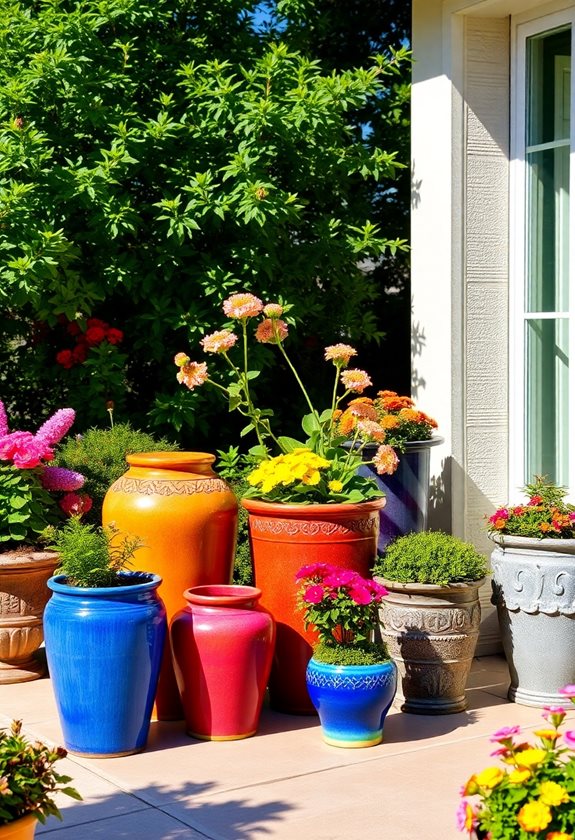
When it comes to container gardening, choosing the right containers can feel a bit intimidating, but it’s actually one of the most fun parts of the process! Think about the materials: plastic, ceramic, or even reclaimed wood—each brings its own flair. Consider drainage too; nobody wants soggy roots! Are you going for a vibrant herb garden or a cascading flower display? Size matters—smaller pots are perfect for herbs, while larger ones can showcase your favorite tomatoes. Mix and match for visual interest! Just remember, whatever you choose should reflect your style and passion. Additionally, consider the drainage features that prevent waterlogging and root rot, ensuring your plants thrive. Ready to plunge into it? Let’s get growing!
Selecting Quality Potting Soil
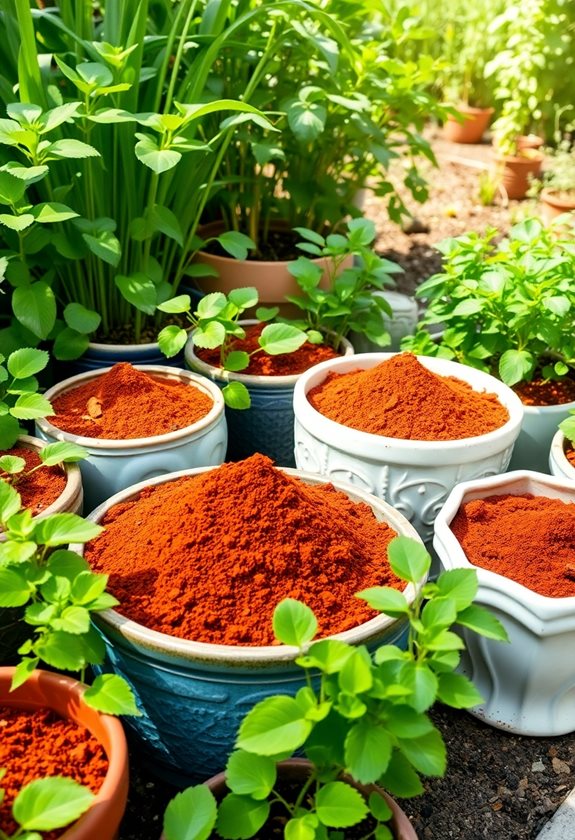
Picking the right containers is just the beginning of your container gardening adventure—now it’s time to talk about what goes inside them! Quality potting soil is essential for thriving plants. Look for a mix that’s lightweight, well-aerated, and rich in organic matter. Have you tried a blend with coconut coir or peat moss? Those retain moisture beautifully! Also, consider added nutrients like compost or slow-release fertilizers. Avoid garden soil; it can compact and suffocate roots. Remember, the right soil can make your plants sing—literally! So, take your time choosing. Your plants will thank you with vibrant growth and blooms! Additionally, consider using self-watering containers, which can help maintain consistent moisture levels in your potting soil for happy, healthy plants.
Understanding Drainage Needs
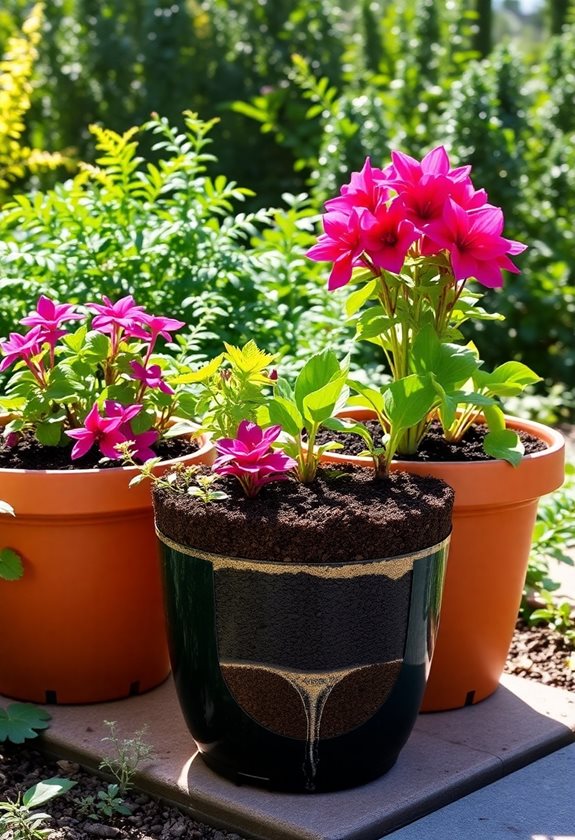
You might not think about it right away, but understanding your plants’ drainage needs is just as essential as choosing the right soil. Too much water can suffocate roots, while too little can dry them out. So, how do you get it right?
Understanding drainage needs is crucial; too much water suffocates roots, while too little dries them out. Get it right for thriving plants!
- Choose pots with drainage holes.
- Consider using a layer of gravel at the bottom.
- Mix in perlite or vermiculite for better aeration.
Trust me, I’ve learned this the hard way! My first container garden became a swamp. With the right drainage, your plants will thrive, and you’ll feel like a gardening pro! Additionally, using essential outdoor containers tailored for herbs can enhance drainage and promote healthy growth.
Watering Techniques for Success
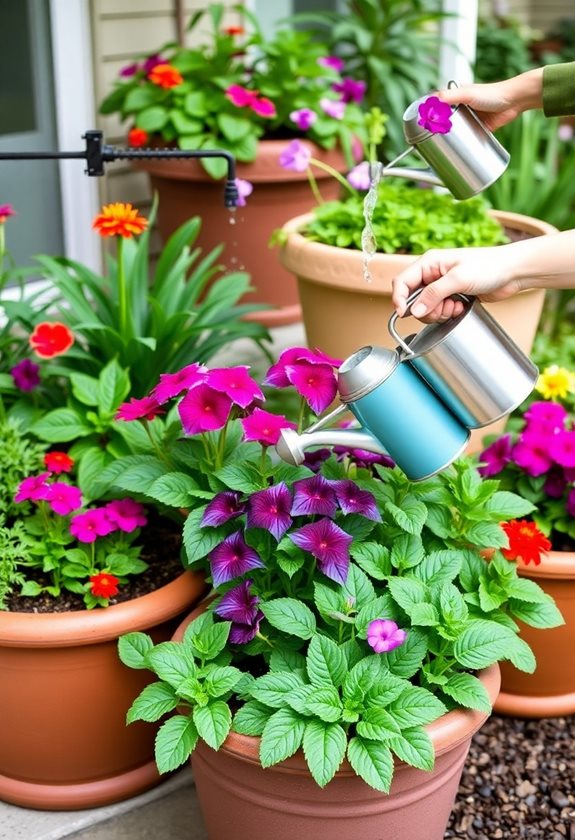
Watering your plants correctly can make all the difference in your container garden, and I’d say it’s about 70% of the battle! You don’t want to drown them, but you also can’t let them dry out. So, how do you find that sweet spot?
- Water deeply but less frequently.
- Check the top inch of soil; if it’s dry, it’s time!
- Consider using self-watering containers for consistency.
Trust me, your plants will thrive with a little attention. Remember, it’s all about balance! Choosing the perfect outdoor garden pots can enhance your watering strategy. Isn’t it exciting to think about how a bit of water can boost your green thumb?
Light Requirements for Different Plants
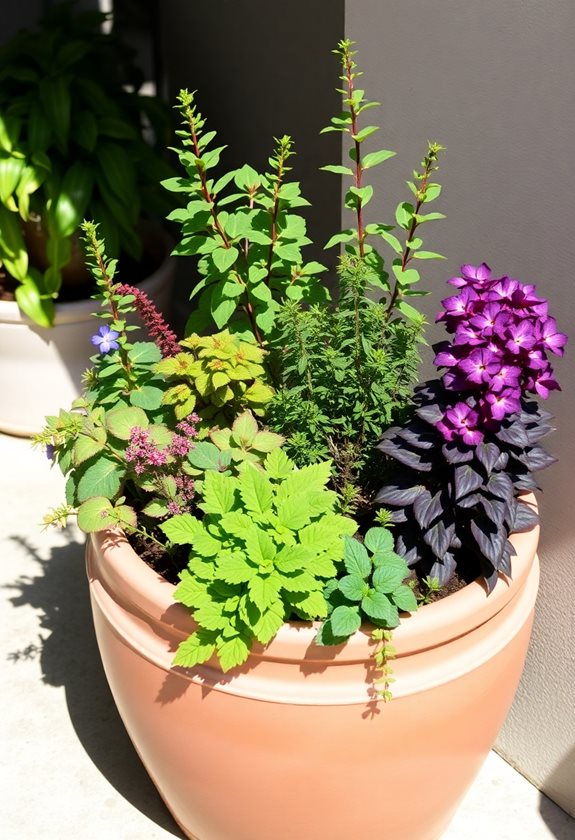
Finding the right light for your plants can feel like a bit of a puzzle, but don’t worry—once you crack it, your container garden will flourish! Consider these light requirements:
- Full sun: Tomatoes and peppers thrive here, needing at least six hours daily.
- Partial sun: Herbs like basil and parsley appreciate some shade, thriving with four to six hours.
- Shade: Leafy greens like spinach and lettuce can grow well in low light.
Experiment with placements and observe how your plants respond. Remember, you’re not just growing plants; you’re cultivating a vibrant garden that reflects your passion! Choosing the right plants based on their light requirements will ensure a successful container garden. Ready to play with light? Let’s do this!
Plant Compatibility and Companion Planting
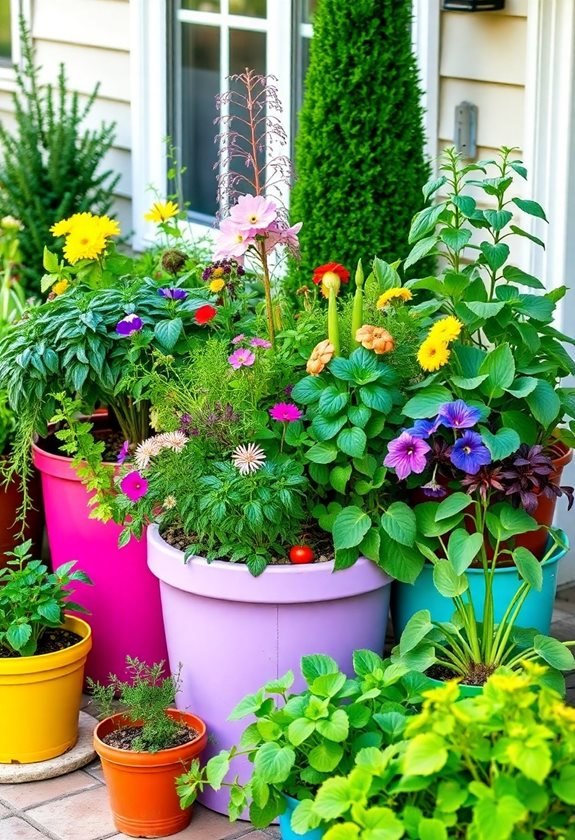
When it comes to planting, many gardeners discover that some plants just get along better than others—kind of like friends at a party! For successful container gardening, consider companion planting. Certain plants enhance each other’s growth, while others can hinder it. For example, basil loves hanging out with tomatoes, boosting their flavor. On the flip side, keep onions away from beans—they don’t play nice!
Here are a few quick tips:
- Pair leafy greens with herbs for pest control.
- Group flowers like marigolds with veggies to attract pollinators, as these flowers can enhance your garden by repelling harmful pests.
Don’t be afraid to experiment; gardening is all about discovering new friendships!
Seasonal Planting Strategies
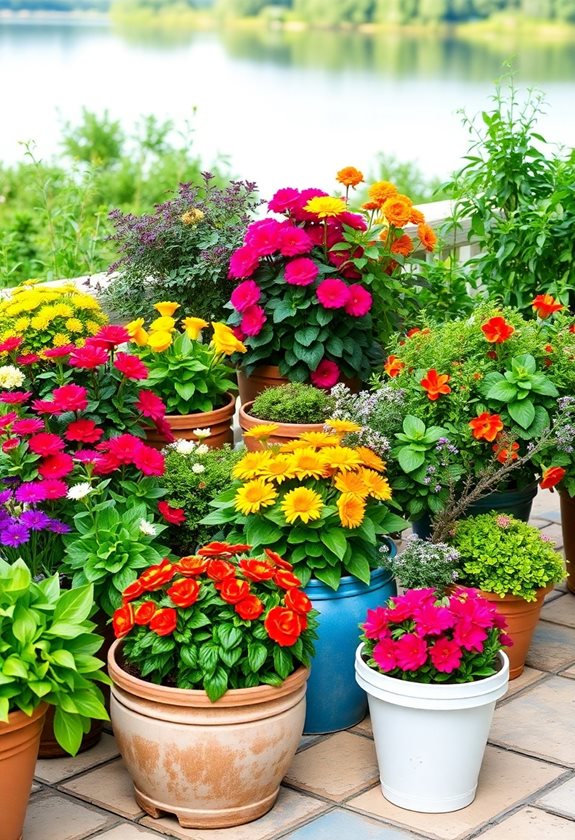
As the seasons change, your container garden can transform right along with them, creating a delightful rhythm of growth and beauty. Embrace seasonal planting by selecting crops that thrive during specific months. For instance, spring invites vibrant pansies and leafy greens, while summer bursts with tomatoes and basil.
Consider rotating your plants; it keeps the soil healthy and maximizes yield.
- In autumn, try hearty kales and chrysanthemums.
- Winter? Ever thought of growing herbs indoors? Year-round container gardening provides endless possibilities for creativity and sustainability.
Adjusting your strategy not only enhances aesthetics but also challenges your gardening skills. What’s your next seasonal adventure? Let your imagination bloom!
Pest Management in Container Gardens
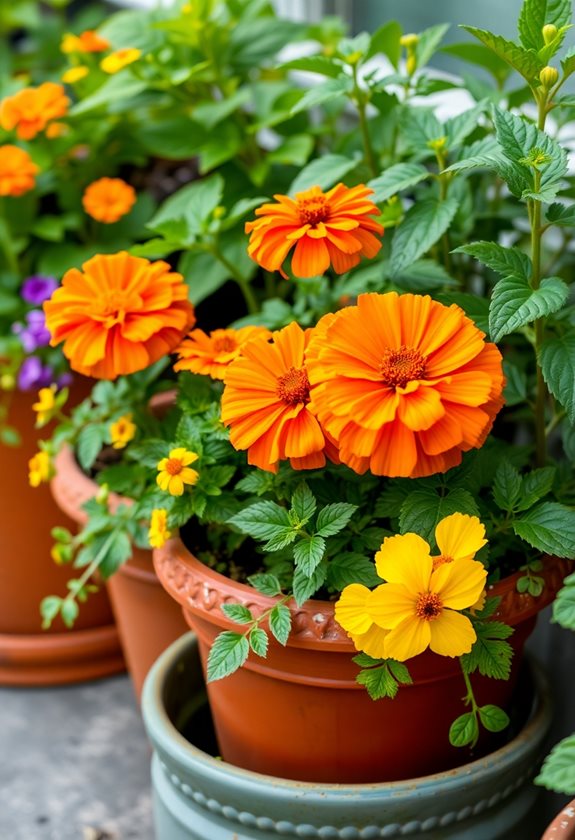
Even the most dedicated gardener can feel a bit overwhelmed when pests decide to crash the party in your container garden. Don’t fret! You’ve got this. Start by regularly inspecting your plants—look for tiny critters or suspicious spots. Introduce beneficial insects like ladybugs or lacewings; they’re nature’s pest control! For a DIY approach, mix water with soap and spritz it on affected leaves. Just remember to test a small area first! It’s all about balance—healthy plants can fend off many pests. And hey, if you spot a caterpillar munching away, maybe it’s time for a friendly chat about boundaries! Additionally, consider incorporating flower companion planting into your gardening strategy to naturally deter pests and promote healthy growth.
Winterizing Your Container Garden
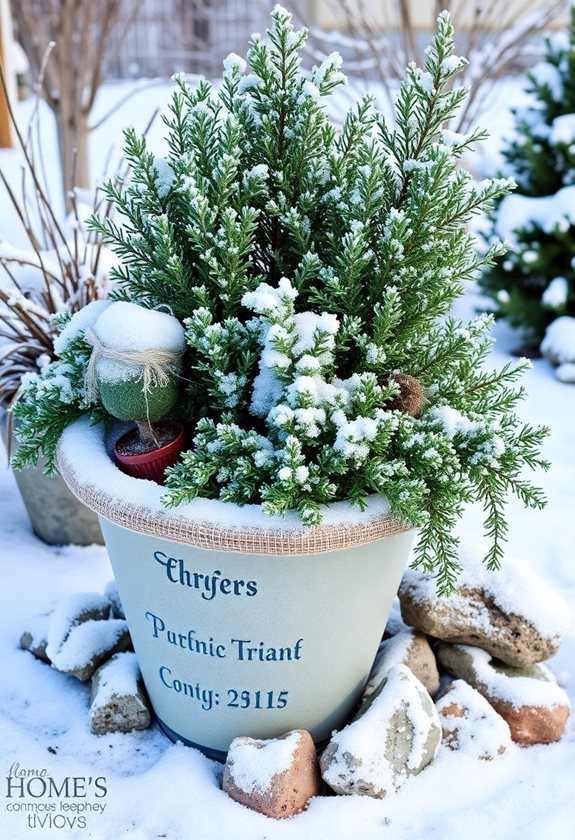
Although winter may seem like a time to bid farewell to your beloved container garden, it’s really just a chance to prepare for the next growing season! Start by trimming back any dead or dying plants. Consider bringing tender perennials indoors; they’ll thrive in a sunny window! For frost-sensitive containers, wrap them in burlap or bubble wrap to insulate the roots. Don’t forget to empty any standing water to prevent freezing. Mulching with straw or leaves can protect your plants, too. Additionally, incorporating low-maintenance plants into your containers can make for an easier transition into spring. Remember, winter isn’t a goodbye; it’s a chance to rejuvenate and plan for your next garden adventure! Ready to plunge in?
Frequently Asked Questions
Can I Use Recycled Materials for Container Gardening?
Picture yourself rummaging through a treasure chest of old cans and bottles instead of scrolling through a store’s gardening aisle! Yes, you can absolutely use recycled materials for container gardening! Think about using items like wooden crates, plastic bottles, or even old tires. Just make sure they have proper drainage holes. You’ll not only save money but also give your plants a unique home. Isn’t it fun to create something beautiful from what you already have?
How Do I Prevent Soil Compaction in Containers?
To prevent soil compaction in your containers, you’ve got a few tricks up your sleeve! First, use a well-draining potting mix—this helps keep air pockets. Second, consider adding materials like perlite or vermiculite; they’re game changers! Finally, when watering, do it gently; heavy pouring can compact the soil. Have you ever noticed how your plants thrive in fluffy soil? Keeping it loose is key to their happiness! Happy gardening!
What Are the Best Fertilizers for Container Plants?
When you think about fertilizers for your container plants, do you wonder if they really make a difference? They absolutely do! Here are some great options:
- Liquid fertilizers: Easy to apply and absorb quickly.
- Slow-release granules: Convenient, releasing nutrients over time.
Make sure to choose one based on your plants’ needs. Remember, a happy plant is a thriving plant! Have fun experimenting; it’s all part of the gardening journey!
How Often Should I Repot My Container Plants?
You should repot your container plants every 1-2 years, depending on their growth. If you notice roots creeping out of the drainage holes or your plant seems stunted, it’s time for a bigger home! Think of it like upgrading to a larger apartment—everyone needs space to thrive! When you do repot, refresh the soil and check for pests. Trust me, your plants will thank you with vibrant growth! Time for a gardening adventure!
Can I Grow Perennials in Containers Year-Round?
Absolutely, you can grow perennials in containers year-round! Imagine having vibrant blooms and lush foliage, even in winter! Just make sure to choose hardy varieties, like ornamental grasses or sedums. Use pots with good drainage and protect them from extreme temperatures. Watering is essential—don’t let them dry out. You’ll be amazed at how much joy these plants can bring to your space, season after season! Ready to give it a try?

